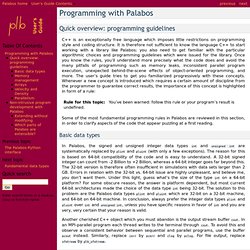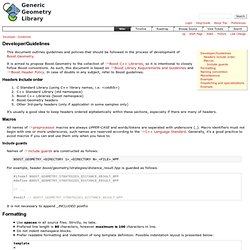

[27] Coding standards Updated! Programming with Palabos — Palabos 0.6 User's Guide. Quick overview: programming guidelines C++ is an exceptionally free language which imposes little restrictions on programming style and coding structure.

It is therefore not sufficient to know the language C++ to start working with a library like Palabos; you also need to get familiar with the particular algorithmic choices and programming guidelines which were issued for the library. Once you know the rules, you’ll understand more precisely what the code does and avoid the many pitfalls of programming such as memory leaks, inconsistent parallel program execution, unexpected behind-the-scene effects of object-oriented programming, and more. The user’s guide tries to get you familiarized progressively with these concepts. Whenever a new concept is introduced which requires a certain amount of discipline from the programmer to guarantee correct results, the importance of this concept is highlighted in form of a rule: Developer/Guidelines – Boost.Geometry. This document outlines guidelines and policies that should be followed in the process of development of Boost.Geometry.

It is aimed to propose Boost.Geometry to the collection of Boost C++ Libraries, so it is intentional to closely follow Boost conventions. As such, this document is based on Boost Library Requirements and Guidelines and Boost Header Policy. In case of doubts in any subject, refer to Boost guidelines. C Standard Library (using C++ library names, i.e. C++ Coding Style, Standards, Practices and dOxygen. Coding practices should be in place to maintain a consistancy among software projects to enforce a disciplines which improves the quality of software, improves reuseability due to more generic interfaces and good documentation, results in software with fewer bugs which is easier to use and maintain.

Camel-case is the practice of changing the letter to upper case to denote the start of a new word. This allows the name to be shorter because no separator character (i.e. "_" used between words.)